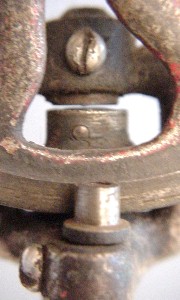
|
The very first No.2 drill
that used the LRRCW to control the running fit between the main gear
and
pinion gear had a very plain thrust bearing. That bearing
supported
the force of pressing the bit against the workpiece being
drilled.
The bearing was a simple cylinder whose position could be adjusted and
held in place with a small screw visible here between the spokes
of the main gear. That simple bearing was not easy to keep
lubricated
and had high friction compared to the efficient solution that appeared
with the more heavily loaded Type K5 and later drills: a row of tiny
steel
balls between the upper end of the spindle and the inside of the
spindle's
bearing housing.
|